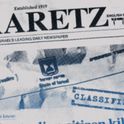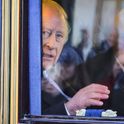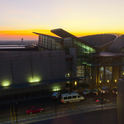I’m sitting in a dusty basement in Kramatorsk and Irina Sydorenko is fretting. Her volunteers are making camouflage nets for Ukrainian soldiers serving along the Contact Line between Ukrainian and Russian-held territory, some 30 miles south-west of this provincial city in eastern Ukraine. Irina is working to fulfill an order from the Ukrainian army for a job-lot of green camouflague nets, but she hasn’t even begun a request from Oleg, a tank commander who badly needs 45 white nets to cover his T-74 tanks for the winter snows expected soon.
“Our volunteers produce about 1,200 square metres a month, but we can’t keep up. We don’t know when the snow will start, but we're getting ready,” she said pointing to a pile of white camouflage nets already produced. “When it falls, it’ll already be too late to hide our lads’ positions.”
I’m here preparing a report for the Royal United Services Institute on aspects of modern war. I‘ve dropped into a voluntary centre run by Irina, a dark-haired and dynamic 61-year-old former machine engineer. Irina is part of Ukraine’s volunteer war effort. Unpaid, as well as making camouflage netting for Ukraine’s frontline positions, she and her team collect clothes, food and other resources. The war is now in its fourth year, and although officially it is described as an anti-terror operation, most in Ukraine are in little doubt that this is a war against Russia and its proxies.
When the Kremlin’s putsches struck home, Ukraine’s military and security services all but collapsed. For years they had been hollowed out not only by ubiquitous post-Soviet corruption, but also by Russia’s attempts to rot the Ukrainian state from within. This subversion was part of an extensive set of overt and covert tools of political/military influence which the Kremlin has used here and elsewhere—elements of its so-called “hybrid war.”
By the winter of 2013 Russia had come close to its goal: Ukraine’s rejection of the EU Association Agreement and its re-admittance into a Russian-led customs union, paving the way for Ukraine’s reabsorption into Russian’s sphere of influence and the gradual death of Ukrainian statehood. It was this situation that prompted the desperate winter uprising of 2014 in the Ukrainian capital of Kiev which overthrew Russia’s man here, Viktor Yanukovich.
In the confusion, Russian President Vladimir Putin collapsed Ukraine’s tenuous hold on Crimea in an operation prepared since 2000 and probably before. The Kremlin also fomented uprisings in eastern and southern Ukraine. Putin hoped for widespread collapse of Kiev’s authority. That dream failed. What the Kremlin got were two partial, political/paramilitary uprisings in Lugansk and Donetsk in eastern Ukraine, “curated” by Russian special services and heavily support by Russian military personnel and equipment.
“When the snow falls, it’ll already be too late to hide our lads’ positions”Irina said that when Russian-backed gunmen appeared, Kramatorsk emptied. “The city died—like some sci-fi movie.” Friends who fled gave Irina their apartment keys and asked her to look after them. She watered their flowers in the hope her friends would soon return. Walking across the city on a balmy July evening, the streets were empty. “I didn’t meet a single person. We didn’t understand what a neighbour—Russia—we had.” However, Russia’s proxy forces couldn’t hold the city and the Ukrainians retook Kramatorsk later that summer of 2014.
The dire state of Ukraine’s armed forces prompted the volunteer effort. Civilians bought drones and medical equipment, whilst others volunteered to fight. These volunteers probably saved Ukraine.
Irina began making souvenirs to raise money for injured young soldiers. Then in September 2014, she had the idea to make nets. Irina facebooked her friends. They set up a group, the Kramatorsk Bees, making nets in the street. Members of the local church volunteered clothes. The deputy mayor offered a basement room. A carpenter constructed large wooden frames, six-foot-high by 10-foot-wide. On these, the volunteers hang nylon fishing nets, and on these nets they tie strips of old brown or grey suits, scarves, cotton T-shirts and anything else that can be used to make the camouflage netting. A friend of Irina’s dyes material when needed. Kramatorsk’s Operation Setka—Operation Net—was born.
We’re interrupted by a stream of visitors. Most are dressed in vishivankas, Ukrainian embroidered shirts which are themselves statements of identity. Sasha, a jovial, white-moustached pensioner has bought pots of home-made blackberry jam. They’ll be sent forward to the Contact Line. Next is Igor, who makes the nets with one hand—his left is withered. Sasha and Nadiya, both internally displaced pensioners from two occupied towns, arrive for their morning sewing stints. “Slava Ukraini—glory to Ukraine,” Nadiya greets Irina. “Heroyam Slava—glory to the heroes,” comes the reply. The team natters as it works—the Bees functions in part as a social club for the keen and the displaced.
“The majority of Ukrainians are now clear where their future lies: west, in Europe”Irina also produces sniper’s ghillie suits—all over, personal camouflague netting used by snipers and hunters. Here, the suits are known as Kikimora, after the wizened swamp creature from Slavic mythology renowned for bringing harm. Irina says the Kikimora are made from old sacks—and affection. “We make ours with love, each knot becomes a talisman for our soldiers,” she says, adjusting one to reinforce the point.
Identity here is still complex. In cities like Kramatorsk, dominated in Soviet times by one or two factories, Soviet mentality died slowly and language and loyalty were mixed. At least one factory owner, known as a tsariok—literally a “little Tsar”—supported the separatists and their Russian backers. But the killing of large numbers of Ukrainian soldiers at the battles of Ilovaysk in 2014 and Debaltseve in 2015 sent a collective shock wave through much, if not all, of this country: Russia was killing its Ukrainian “brothers.” Putin had achieved what Ukraine’s poor leadership and divided loyalties failed to achieve in 25 years; the creation of a political Ukrainian state and identity. With 10,000 people dead in this conflict, open pro-Russian support is now publically unacceptable.
The majority of Ukrainians are now clear where their future lies: west, in Europe. The difference between Moscow and Kiev now is over imagined futures. The security elites who control Russia envisage a future in “geopolitical” opposition to the West. Its military and national security doctrines identify clear threats: the US and NATO, a method of war: all the tools of the state, and a battle over civilisational values. The Russian people are being indoctrinated to this reality. By comparison, Ukrainians see their future in a democratic state partnered with the West. This move west is a psychological journey embracing civil rights and civil society. This is not starry-eyed: there is a realisation that Ukraine’s own leaders leave much to be desired.
Meanwhile, Ukraine settles in for a long war. Life is returning to partial normality. There is still daily shelling from Russian troops and their proxies, but the borders of this war may not move for the next year or so thanks to the 2018 World Cup in Russia. Irina knows when the war will end. She refers to the dream of a priest who fell asleep and awoke to name the war’s end on October 4th. “But he didn’t say what year,” she laments. In the meantime, Ukrainians here are being forced to learn how to counter their Russian neighbour and its myriad forms of confrontation. It is a style of conflict which we in Britain need better to understand too.












